The Reb1-homologue Ydr026c/Nsi1 is required for efficient RNA polymerase I termination in yeast
- PMID: 22805593
- PMCID: PMC3419925
- DOI: 10.1038/emboj.2012.185
The Reb1-homologue Ydr026c/Nsi1 is required for efficient RNA polymerase I termination in yeast
Abstract
Several DNA cis-elements and trans-acting factors were described to be involved in transcription termination and to release the elongating RNA polymerases from their templates. Different models for the molecular mechanism of transcription termination have been suggested for eukaryotic RNA polymerase I (Pol I) from results of in vitro and in vivo experiments. To analyse the molecular requirements for yeast RNA Pol I termination, an in vivo approach was used in which efficient termination resulted in growth inhibition. This led to the identification of a Myb-like protein, Ydr026c, as bona fide termination factor, now designated Nsi1 (NTS1 silencing protein 1), since it was very recently described as silencing factor of ribosomal DNA. Possible Nsi1 functions in regard to the mechanism of transcription termination are discussed.
Conflict of interest statement
The authors declare that they have no conflict of interest.
Figures





Similar articles
-
Binding of the termination factor Nsi1 to its cognate DNA site is sufficient to terminate RNA polymerase I transcription in vitro and to induce termination in vivo.Mol Cell Biol. 2014 Oct;34(20):3817-27. doi: 10.1128/MCB.00395-14. Epub 2014 Aug 4. Mol Cell Biol. 2014. PMID: 25092870 Free PMC article.
-
Co-transcriptional RNA cleavage provides a failsafe termination mechanism for yeast RNA polymerase I.Nucleic Acids Res. 2011 Mar;39(4):1439-48. doi: 10.1093/nar/gkq894. Epub 2010 Oct 23. Nucleic Acids Res. 2011. PMID: 20972219 Free PMC article.
-
Binding sites for abundant nuclear factors modulate RNA polymerase I-dependent enhancer function in Saccharomyces cerevisiae.J Biol Chem. 1995 Dec 1;270(48):28723-32. doi: 10.1074/jbc.270.48.28723. J Biol Chem. 1995. PMID: 7499394
-
The mechanism of transcription termination by RNA polymerase I.Mol Microbiol. 1994 Apr;12(1):11-5. doi: 10.1111/j.1365-2958.1994.tb00989.x. Mol Microbiol. 1994. PMID: 8057832 Review.
-
Terminating transcription in eukaryotes: lessons learned from RNA polymerase I.Trends Biochem Sci. 1997 Dec;22(12):473-7. doi: 10.1016/s0968-0004(97)01133-x. Trends Biochem Sci. 1997. PMID: 9433127 Review.
Cited by
-
High-Resolution Genome-Wide Occupancy in Candida spp. Using ChEC-seq.mSphere. 2020 Oct 14;5(5):e00646-20. doi: 10.1128/mSphere.00646-20. mSphere. 2020. PMID: 33055256 Free PMC article.
-
Defining the Influence of the A12.2 Subunit on Transcription Elongation and Termination by RNA Polymerase I In Vivo.Genes (Basel). 2021 Nov 30;12(12):1939. doi: 10.3390/genes12121939. Genes (Basel). 2021. PMID: 34946888 Free PMC article.
-
Mechanism of Regulation of Intrachromatid Recombination and Long-Range Chromosome Interactions in Saccharomyces cerevisiae.Mol Cell Biol. 2016 May 2;36(10):1451-63. doi: 10.1128/MCB.01100-15. Print 2016 May 15. Mol Cell Biol. 2016. PMID: 26951198 Free PMC article.
-
Regulation of ribosomal RNA gene copy number, transcription and nucleolus organization in eukaryotes.Nat Rev Mol Cell Biol. 2023 Jun;24(6):414-429. doi: 10.1038/s41580-022-00573-9. Epub 2023 Feb 2. Nat Rev Mol Cell Biol. 2023. PMID: 36732602 Review.
-
ChEC-seq kinetics discriminates transcription factor binding sites by DNA sequence and shape in vivo.Nat Commun. 2015 Oct 22;6:8733. doi: 10.1038/ncomms9733. Nat Commun. 2015. PMID: 26490019 Free PMC article.
References
-
- Bryk M, Banerjee M, Murphy M, Knudsen KE, Garfinkel DJ, Curcio MJ (1997) Transcriptional silencing of Ty1 elements in the RDN1 locus of yeast. Genes Dev 11: 255–269 - PubMed
-
- Chasman DI, Lue NF, Buchman AR, LaPointe JW, Lorch Y, Kornberg RD (1990) A yeast protein that influences the chromatin structure of UASG and functions as a powerful auxiliary gene activator. Genes Dev 4: 503–514issn: 0890-9369 - PubMed
Publication types
MeSH terms
Substances
LinkOut - more resources
Full Text Sources
Molecular Biology Databases
Research Materials

